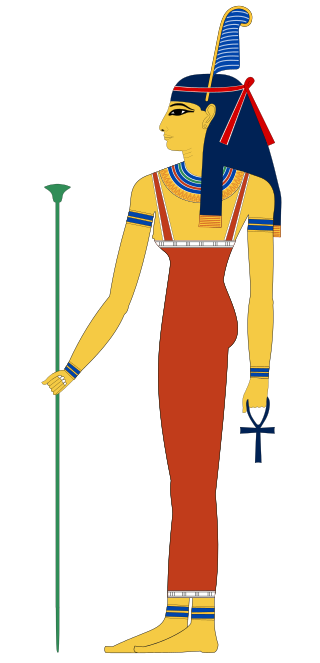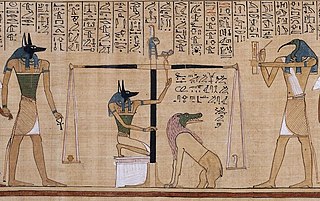


The Apis Papyrus is an ancient Egyptian artifact, the work of scribes upon papyrus, concerning the Apis bull. [2]



The Apis Papyrus is an ancient Egyptian artifact, the work of scribes upon papyrus, concerning the Apis bull. [2]
The text on the papyrus is written in hieratic-demotic script, and the inscriptions are the work of two scribes. [3] [4]
According to one source the papyrus was written during the middle of the 2nd century BC, another source dates the papyrus to a period falling within the 26th Dynasty, and a third considers the papyrus dates to the 1st century C.E. [3] [5] [6] [2]
The text shows details of the burial rites and ritual of performing an embalming of the Apis, particularly the last parts or stages of the embalming. [3] [7]
D.K. Sharpes states the ritual extended to seventy days. Priests performing the ritual were required to maintain hair at a long length, not bathe, to wear costumes made especially for the purposes of the fulfilment of the ritual, wail loudly, fast for four days and abstain from milk and meat for the remaining sixty-six days. [5]
The papyrus was purchased in 1821 by Dr Ernst August Burghart for the Münz und Antikencabinet at a cost of 200 Guilders Konventionsmünze. [4]
Heinrich Brugsch was the first scholar to study the papyrus. In 1886, von Bergmann published a photolithograph of it, and in 1920 Wilhelm Spiegelberg published the first translation. The papyrus was contained within the Kunsthistoriches Museum at a time circa 1993. [4]

Anubis, also known as Inpu, Inpw, Jnpw, or Anpu in Ancient Egyptian, is the god of funerary rites, protector of graves, and guide to the underworld, in ancient Egyptian religion, usually depicted as a canine or a man with a canine head.

Osiris is the god of fertility, agriculture, the afterlife, the dead, resurrection, life, and vegetation in ancient Egyptian religion. He was classically depicted as a green-skinned deity with a pharaoh's beard, partially mummy-wrapped at the legs, wearing a distinctive atef crown, and holding a symbolic crook and flail. He was one of the first to be associated with the mummy wrap. When his brother Set cut him up into pieces after killing him, Osiris' wife Isis found all the pieces and wrapped his body up, enabling him to return to life. Osiris was widely worshipped until the decline of ancient Egyptian religion during the rise of Christianity in the Roman Empire.

Memphis, or Men-nefer, was the ancient capital of Inebu-hedj, the first nome of Lower Egypt that was known as mḥw ("North"). Its ruins are located in the vicinity of the present-day village of Mit Rahina, in markaz (county) Badrashin, Giza, Egypt. This modern name is probably derived from the late Ancient Egyptian name for Memphis mjt-rhnt meaning "Road of the Ram-Headed Sphinxes".

Nephthys or Nebet-Het in ancient Egyptian was a goddess in ancient Egyptian religion. A member of the Great Ennead of Heliopolis in Egyptian mythology, she was a daughter of Nut and Geb. Nephthys was typically paired with her sister Isis in funerary rites because of their role as protectors of the mummy and the god Osiris and as the sister-wife of Set.

Maat or Maʽat comprised the ancient Egyptian concepts of truth, balance, order, harmony, law, morality, and justice. Ma'at was also the goddess who personified these concepts, and regulated the stars, seasons, and the actions of mortals and the deities who had brought order from chaos at the moment of creation. Her ideological opposite was Isfet, meaning injustice, chaos, violence or to do evil.

In ancient Egyptian religion, Apis or Hapis, alternatively spelled Hapi-ankh, was a sacred bull or multiple sacred bulls worshiped in the Memphis region, identified as the son of Hathor, a primary deity in the pantheon of ancient Egypt. Initially, he was assigned a significant role in her worship, being sacrificed and reborn. Later, Apis also served as an intermediary between humans and other powerful deities.

Seshat was the ancient Egyptian goddess of writing, wisdom, and knowledge. She was the daughter of Thoth. She was seen as a scribe and record keeper; her name means "female scribe". She is credited with inventing writing. She also became identified as the goddess of sciences, accounting, architecture, astronomy, astrology, building, mathematics, and surveying.

The Book of the Dead is an ancient Egyptian funerary text generally written on papyrus and used from the beginning of the New Kingdom to around 50 BC. The original Egyptian name for the text, transliterated r(ꜣ)w n(y)w prt m hrw(w), is translated as Book of Coming Forth by Day or Book of Emerging Forth into the Light. "Book" is the closest term to describe the loose collection of texts consisting of a number of magic spells intended to assist a dead person's journey through the Duat, or underworld, and into the afterlife and written by many priests over a period of about 1,000 years. In 1842, the Egyptologist Karl Richard Lepsius introduced for these texts the German name Todtenbuch, translated to English as 'Book of the Dead'.

Menmaatre Ramesses XI reigned from 1107 BC to 1078 BC or 1077 BC and was the tenth and final pharaoh of the Twentieth Dynasty of Egypt and as such, was the last king of the New Kingdom period. He ruled Egypt for at least 29 years although some Egyptologists think he could have ruled for as long as 30. The latter figure would be up to 2 years beyond this king's highest known date of Year 10 of the Whm Mswt era or Year 28 of his reign. One scholar, Ad Thijs, has suggested that Ramesses XI could even have reigned as long as 33 years.
Ancient Egyptian mathematics is the mathematics that was developed and used in Ancient Egypt c. 3000 to c. 300 BCE, from the Old Kingdom of Egypt until roughly the beginning of Hellenistic Egypt. The ancient Egyptians utilized a numeral system for counting and solving written mathematical problems, often involving multiplication and fractions. Evidence for Egyptian mathematics is limited to a scarce amount of surviving sources written on papyrus. From these texts it is known that ancient Egyptians understood concepts of geometry, such as determining the surface area and volume of three-dimensional shapes useful for architectural engineering, and algebra, such as the false position method and quadratic equations.

The Edwin Smith Papyrus is an ancient Egyptian medical text, named after Edwin Smith who bought it in 1862, and the oldest known surgical treatise on trauma. From a cited quotation in another text, it may have been known to ancient surgeons as the "Secret Book of the Physician".

The ancient Egyptians had an elaborate set of funerary practices that they believed were necessary to ensure their immortality after death. These rituals included mummifying the body, casting magic spells, and burials with specific grave goods thought to be needed in the afterlife.

Egyptian medical papyri are ancient Egyptian texts written on papyrus which permit a glimpse at medical procedures and practices in ancient Egypt. These papyri give details on disease, diagnosis, and remedies of disease, which include herbal remedies, surgery, and magical incantations. Many of these papyri have been lost due to grave robbery. The largest study of the medical papyri to date has been undertaken by Humboldt University of Berlin and was titled Medizin der alten Ägypter.

Papyrus is a Belgian comic book series, written and illustrated by Lucien De Gieter. The story takes place in Ancient Egypt. It was first published in 1974 in Spirou magazine in the form of episodes.

Animal mummification was common in ancient Egypt. Animals were an important part of Egyptian culture, not only in their role as food and pets, but also for religious reasons. Many different types of animals were mummified, typically for four main purposes: to allow people's beloved pets to go on to the afterlife, to provide food in the afterlife, to act as offerings to a particular god, and because some were seen as physical manifestations of specific deities that the Egyptians worshipped. Bastet, the cat goddess, is an example of one such deity. In 1888, an Egyptian farmer digging in the sand near Istabl Antar discovered a mass grave of felines, ancient cats that were mummified and buried in pits at great numbers.

The Serapeum of Saqqara was the ancient Egyptian burial place for sacred bulls of the Apis cult at Memphis. It was believed that the bulls were incarnations of the god Ptah, which would become immortal after death as Osiris-Apis, a name which evolved to Serapis (Σέραπις) in the Hellenistic period, and Userhapi (ⲟⲩⲥⲉⲣϩⲁⲡⲓ) in Coptic. It is part of the Saqqara necropolis, which includes several other animal catacombs, notably the burial vaults of the mother cows of the Apis.
The Papyrus Vindobonensis Graecus 39777 signed as SymP.Vindob.G.39777 – is a fragment of a Greek manuscript of the Psalms of the translation of Symmachus. It was written in papyrus in a scroll form. The papyrus contains fragments of Psalm 69 and Psalm 81. The P.Vindob.G.39777 is dated to late third century or beginning fourth century AD.

The Ancient Egyptian anatomical studies is an article about the history of anatomy within ancient Egypt.
The Ritual of Embalming Papyrus or Papyrus of the Embalming Ritual is one of only two extant papyri which detail anything at all about the practices of mummification used within the burial practices of Ancient Egyptian culture.

The Mysteries of Osiris were religious festivities celebrated in ancient Egypt to commemorate the murder and regeneration of Osiris. The course of the ceremonies is attested by various written sources, but the most important document is the Ritual of the Mysteries of Osiris in the Month of Khoiak, a compilation of Middle Kingdom texts engraved during the Ptolemaic period in an upper chapel of the Temple of Dendera. In Egyptian religion, the sacred and the secret are intimately linked. As a result, ritual practices were beyond the reach of the uninitiated, as they were reserved for the priests, the only ones authorised to enter the divine sanctuaries. The most unfathomable theological mystery, the most solemnly precautionary, is the remains of Osiris. According to the Osirian myth, this mummy is kept deep in the Duat, the subterranean world of the dead. Every night, during his nocturnal journey, Ra, the solar god, came there to regenerate by temporarily uniting with Osiris in the form of a single soul.